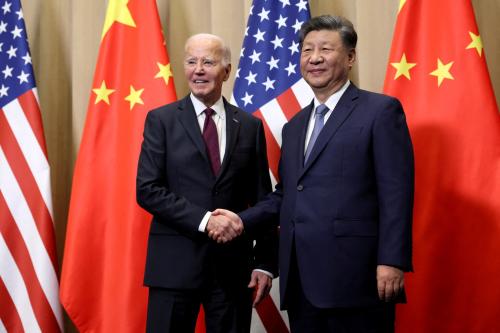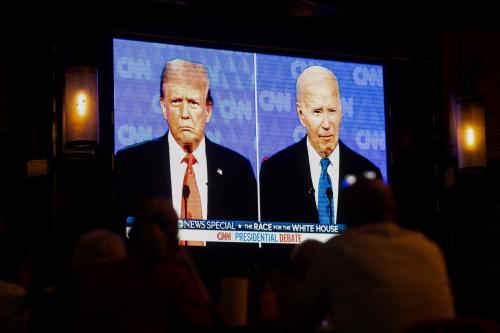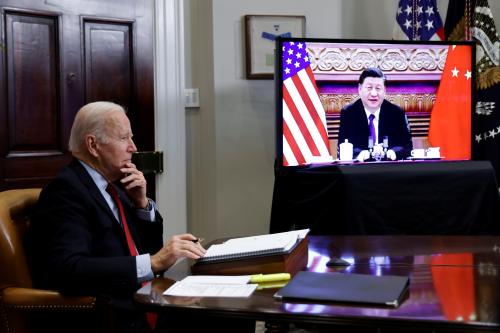When it comes to China, President Biden is largely continuing Donald Trump’s approach. Secretary of State Antony Blinken has indicated that there are three types of issue areas when it comes to China: ones where we will confront China, ones where we will compete, and ones where we can cooperate on the basis of common interests. In the first 100 days the emphasis has been on confrontation, with competition also being prominent. There is little evidence of cooperation, the one exception being Xi Jinping’s participation in Biden’s virtual climate summit.
Confrontation
The Biden team was in no hurry to deal with China, waiting a long time to schedule a first phone call between the presidents or to have any high-level meetings. Secretary Blinken met with his counterpart, State Councilor Yang Jiechi, in Alaska on the way back from his first overseas trip, to Japan and South Korea. The meeting got off to a rocky start as Blinken criticized China with the TV cameras rolling. This initial frosty exchange made it clear that there would be no re-set in U.S.-China relations. Trump’s Secretary of State, Mike Pompeo, had made similarly harsh public statements about China. One important nuance is that the Biden team has discontinued the demonization of the Chinese Communist Party and the implied calls for regime change.
On the security side, so far the Biden administration has maintained and even stepped up enhanced engagement with Taiwan. They have continued high-level contacts with Taiwanese officials and arms sales; under the Taiwan Relations Act the U.S. has an obligation to ensure that Taiwan can defend itself. The Defense Department is reviewing China policy. The likely outcome of the review is some shift of military resources away from the Middle East (witness the withdrawal from Afghanistan) to the Asia-Pacific to counter China—within the context of a flat real defense budget proposed by the president.
Competition
A third area of continuity is in the economic realm. Candidate Biden criticized Trump’s tariffs aimed at China as a poorly targeted instrument that hurts the American economy (a Federal Reserve study found that they cost us more than 100,000 jobs). Nevertheless, the new administration is leaving the tariffs in place for the moment, as well as the “Phase 1” trade deal in which China agreed to make large purchases of specific American products (soybeans and other agricultural products, oil and gas, manufactures). This is a two-year agreement which at the mid-point is achieving mixed results. U.S. exports to China are up and are a rare bright spot in U.S. trade, but the amounts will fall far short of the agreed targets. USTR (United States Trade Representative) Katherine Tai has indicated a willingness to negotiate with China, but there are no talks planned and a lack of high-level appointees in the Trade Representative’s Office, Treasury, and Commerce who would be needed for comprehensive economic discussions.
Technology has been emphasized by the new administration as an area of competition with China. Biden’s language has been more about seeing China as a competitor than as treating China as an adversary. The administration is proposing ambitious spending on infrastructure, broadly defined to include more funds for R&D and targeting of particular technologies, and further spending on family-friendly policies such as universal pre-K, improved health services, and support to taking care of the aged. In the administration and in Congress much of this is defended as needed to compete with China and to prevent China from dominating the technologies of the future. These efforts to increase innovation in the U.S. are complemented by various efforts to limit diffusion of technology to China via export and investment restrictions. These policies started under Trump and have been modestly expanded under Biden. Treasury and Commerce Departments are reviewing these sanctions and there may be some modest fine-tuning once the reviews are over.
Cooperation
The only real area of cooperation between China and the U.S. so far is that President Xi Jinping was one of the dozens of heads of state who participated in Biden’s virtual climate summit on April 22. Xi recently announced the goal of carbon neutrality by 2060, a less ambitious target than the 2050 date set by Biden, the EU, and Japan. Xi did not use the event to alter China’s recent pledge, but stressed that the rich countries have a special obligation to reduce carbon emissions quickly and to provide promised financing to assist the developing world adjust to a low-carbon future. The summit was a useful pressure point in advance of the UN climate summit in Glasgow in November. Climate could be an area of cooperation between China and the West, though it could also devolve into a new competition as the U.S. administration pressures China to set more ambitious targets, to get serious about them in the current five-year plan, and to stop financing coal-fired power plants throughout the developing world as part of its Belt and Road Initiative.
What we have learned from the first 100 days is that we are likely to have both a confrontational and competitive relationship with China, similar to Trump’s policy but with some important nuances. President Biden has emphasized rebuilding partnerships with allies in order to counter China. The allies welcome the return of the U.S. to multilateralism, but most of them are not interested in a new Cold War. This was evident in Blinken’s visit to South Korea, initial discussions with European allies, and the visit of Japanese Prime Minister Suga to Washington. Our allies have deeper trade and investment relations with China than we do; and, in fact, since Biden’s election the EU, Japan, South Korea, Australia, New Zealand, and ASEAN have all signed new economic agreements with China. There is some contradiction between the U.S. confronting China and working multilaterally, so it is likely that over time Biden’s China policy will have to become either less confrontational or more unilateral.
The Brookings Institution is committed to quality, independence, and impact.
We are supported by a diverse array of funders. In line with our values and policies, each Brookings publication represents the sole views of its author(s).








Commentary
What does Biden’s first 100 days tell us about his approach to China?
April 26, 2021